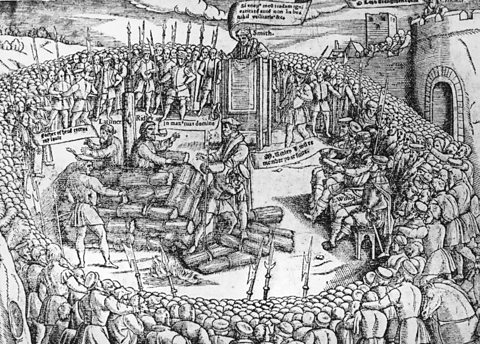New crimes in early modern England
Changes in early modern England led to new crimes. These changes included the Reformation, a growth in population and an increase in enclosureThe process of reducing the huge number of small landholdings to create larger, more efficient farms. It is often argued that there was an increase in crime during this period because of these new crimes being defined.
Heresy

heresy To disagree with, or refuse to follow the religious views of the monarch or the state. increased in early modern England because of the introduction of the Protestant Church during the reign of Henry VIII. As the official religion in England changed from Catholic to Protestant, and back again, the decades following Henry VIIIâs reign saw an increase in heresy-related crime. Those people who committed heresy were known as hereticSomeone who challenges the beliefs of the church. and were often burned at the stake.
Those who refused to accept the new Protestant Church during the reign of Henry VIII were executed. Mary I (a Catholic) ordered the execution of nearly 300 Protestants during her reign, and Elizabeth I (a Protestant) had nearly 250 Catholics executed.
Vagabondage
During this period, the population increased, wages fell, food prices rose and people moved around the country searching for work. As a result, people became concerned about vagabonds, or vagrant±«Óătvless, unemployed person who wandered the streets. who committed crimes such as theft, assault and murder. People in early modern England wanted to help poor people who lived in their community and were known to them. However, they viewed vagrants as suspicious, sinful and potential criminals because they were unfamiliar to the community. Pamphlets listing the different types of vagrants were shared in communities. For example:
- drummerers - people pretending to be deaf and non verbal
- freshwater mariners and whipjacks - beggars who were, or pretended to be, ex-sailors and said they had been attacked by pirates
- kinchin morts - young female beggars
- priggers of prancers - horse thieves
There was an increase in vagrants during times of poor harvests and economic hardships. For example, the poor harvest in 1597 caused widespread poverty and suffering.
The Vagrancy Acts
New laws were passed to deal with the perceived threat of vagrants. In 1547 a harsh Vagrancy Act was passed by the government. An able-bodied vagrant - man or woman - who had been out of work for more than three days was brandingMarking a personâs skin with a hot iron. Vagrants were branded with a letter V for example. with the letter âVâ and sentenced to two years of slavery if this was their first offence. For their second offence, they were sentenced to slavery for life or execution.
In 1550 this act was repealedWhen a law is officially withdrawn. because it was deemed too harsh. The government instead used corporal punishment, such as whipping. After being whipped, offenders were returned to their birthplace or place of residence.
A further Vagrancy Act was passed in 1597. It stated that vagrants who did not change their ways could have an ear burned using a hot iron and be sent into exileWhen someone is away from their home country and is refused permission to return. or executed.
In 1601, Elizabeth I passed the Poor Law. This distinguished between the âundeserving poorâ and the âdeserving poorâ:
- The elderly and disabled were now part of the deserving poor and would receive poor relief funding from parish churches.
- Vagrants were now part of the undeserving poor. They could be sent to a house of correction, where they would be whipped.
The Witchcraft Acts
Religious changes during the reigns of the Tudors led to a period of uncertainty and unrest. There was an increase in accusations of witchcraft as:
- Changes in religion alongside economic problems, including poor harvests and rising unemployment, led to distrust and tension among communities.
- Poor harvests and deaths of livestock were often blamed on witchcraftIn a historical context, this was thought to be a kind of magic that could be used to cause harm to people or property. Witches were often accused of obtaining their power from the Devil. rather than poor conditions or bad luck.
Most people in England believed that witchcraft existed and should be stopped and punished severely. In 1542, during the reign of Henry VIII, a Witchcraft Act was passed. It made witchcraft a criminal offence and punishable by death. It was repealed five years later but then restored in 1563. It said that trials would be held in a common court, not the lenient Church court. It also stated that punishment by death should only be used when harm had been caused by the person accused of being a witch.
In 1604, a further Witchcraft and Conjuration Act was passed during the reign of James I. This added the death penalty for anyone convicted of summoning evil spirits. This new act stated that those accused of minor witchcraft offences were to be punished with a year in prison. However, they were to be executed if they were found guilty a second time.
Smuggling
- The English began to expand their knowledge of the world during the 16th and 17th centuries. As explorers discovered more of the New WorldNorth and South America. there was an increase in new luxury goods being imported into England, such as alcohol, tea and herbs.
- The government introduced import dutyTax put on goods arriving in one country from another. on these goods.
- However, there were some people who wanted to make their own money from these goods and smuggled them into the country without paying the tax.
- Smuggling was seen as a social crime An illegal act that people within society do not see as a crime. because some people were happy to buy cheaper goods from smugglers and they did not see smuggling as a crime.